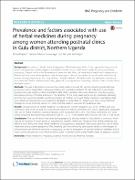| dc.contributor.author | Nyeko, Richard | |
| dc.contributor.author | Tumwesigye, Nazarius Mbona | |
| dc.contributor.author | Halage, Abdullah Ali | |
| dc.date.accessioned | 2021-07-29T09:11:02Z | |
| dc.date.available | 2021-07-29T09:11:02Z | |
| dc.date.issued | 2016 | |
| dc.identifier.citation | Nyeko, R., Tumwesigye, N. M., & Halage, A. A. (2016). Prevalence and factors associated with use of herbal medicines during pregnancy among women attending postnatal clinics in Gulu district, Northern Uganda. BMC pregnancy and childbirth, 16(1), 1-12. | en_US |
| dc.identifier.uri | https://hdl.handle.net/123456789/306 | |
| dc.description.abstract | Background: According to World Health Organization (WHO) estimates, 80 % of the population living in rural
areas in developing countries depends on traditional medicine for their health needs, including use during
pregnancy. Despite the fact that knowledge of potential side effects of many herbal medicines in pregnancy is
limited and that some herbal products may be teratogenic, data on the extent of use of herbal medicines by
women during pregnancy in the study setting is largely unknown. We determined the prevalence and factors
associated with herbal medicine use during pregnancy among women attending postnatal clinics in Gulu district,
Northern Uganda.
Methods: This was a descriptive cross-sectional study which involved 383 women attending postnatal care
across four sites in Gulu district using quantitative and qualitative methods of data collection. A structured
questionnaire was used to collect quantitative data while qualitative data were obtained using focus group
discussions and key informant interviews. The selection of the study participants was by systematic sampling
and the main outcome variable was the proportion of mothers who used herbal medicine. Quantitative data
was coded and entered into a computerized database using Epidata 3.1. Analysis was done using Statistical
Package for Social Scientists version 13, while thematic analysis was used for qualitative data.
Results: The prevalence of herbal medicines use during the current pregnancy was 20 % (78/383), and was
commonly used in the second 23 % (18/78) and third 21 % (16/78) trimesters. The factors significantly associated
with use of herbal medicines during pregnancy were perception (OR 2.18, CI 1.02-4.66), and having ever used
herbal medicines during previous pregnancy (OR 2.51, CI 1.21-5.19) and for other reasons (OR 3.87, CI 1.46-10.25).
Conclusions: The use of herbal medicines during pregnancy among women in Gulu district is common, which
may be an indicator for poor access to conventional western healthcare. Perception that herbal medicines are
effective and having ever used herbal medicines during previous pregnancy were associated with use of herbal
medicines during current pregnancy. This therefore calls for community sensitization drives on the dangers of
indiscriminate use of herbal medicine in pregnancy, as well as integration of trained traditional herbalists and all
those community persons who influence the process in addressing the varied health needs of pregnant women. | en_US |
| dc.language.iso | en | en_US |
| dc.publisher | BMC Pregnancy and Childbirth | en_US |
| dc.subject | Herbal medicines | en_US |
| dc.subject | Pregnancy | en_US |
| dc.subject | Maternal health services | en_US |
| dc.subject | Maternal mortality | en_US |
| dc.title | Prevalence and factors associated with use of herbal medicines during pregnancy among women attending postnatal clinics in Gulu district, Northern Uganda | en_US |
| dc.type | Article | en_US |

